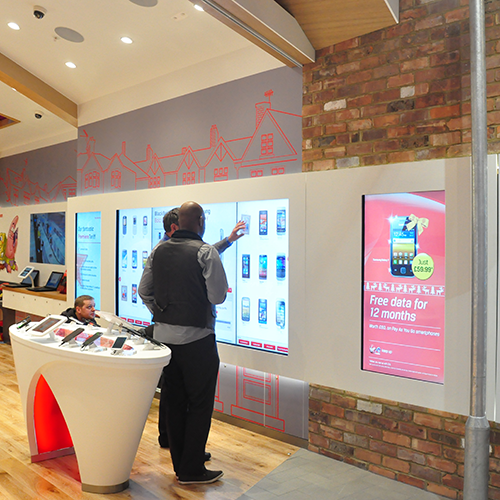Josh Bunce, CEO of Inurface Media, spells out how clever use of in-store experiential technology can draw customers in and help drive sales
After an unprecedented and unpredictable year, Covid has accelerated the transformation of retail more than we would ever have predicted. Now, with the reopening of stores across the UK retailers need to work harder than ever to encourage consumers off their sofas, away from their laptops and into stores.
For high-value items, such as kitchens, bathrooms or fitted bedrooms, customers are considering investing a significant amount of money. Many are faced with greater financial insecurity than pre-Covid, meaning retailers need to do more than ever to instil confidence when customers cross the threshold of their stores.
Creative use of experiential technology, impactful visual installations and clever and engaging signage can do just this, but for it to hit the mark there are a few steps all retailers can follow.
It is inarguable that the past year has transformed how people shop. We have seen the fall of some of the biggest names on the high street and a huge growth in online and alternative retail methods. As stores closed their doors due to government restrictions, consumers have grown used to browsing on the internet rather than in person, the next-day delivery economy, and the ability to buy without interacting with salespeople or stores at all.
It is not surprising that people are happy to buy lower-value items without seeing them, knowing they can return any items that don’t meet expectation. But even for higher-value items, not being able to view before purchase no longer seems to be the barrier it once was.
It is because of this, that this type of retailer specifically needs to rethink their strategy. They need to add value to justify the rent and offer more than their competitors who operate solely online. They need to demonstrate that by entering a store you are getting more and risking less than shopping online.
It is likely that we will see a reduction in the number of stores that stay open, but that the investment in those that remain will also increase. The concept of flagship stores will become all the more relevant for those looking for additional support and engagement in their purchase and competition between brands in this space will be more evident than ever.
Stores need to entice and engage. While customers are likely to be considered purchasers, rather than impulse browsers, interesting video displays and screens can encourage individuals into one store over another – vital if you are operating in close proximity to competitors. But their role can be much greater than this.
Clever use of technology, such as the use of information totems or touch-screen devices, are also ways of clearly communicating advice and information. This may be useful, given the current climate, to reassure visitors and increase their comfort in being within the store, while also potentially, subconsciously, increasing their trust in the brand.
It could be screens at an entrance clearly directing consumers how best to use the store’s facilities, or in the windows, showing products in real-life settings that help sell the aspirational lifestyle in a much more visually engaging way than on a small laptop or computer screen.
Salespeople can also use this technology to work with clients to create their vision right before their eyes. Combining traditional sales techniques with new technology, they are demonstrating the benefit of their advice and presence over what can be found remotely.
From a retailer’s perspective, these installations can have an additional benefit. The technology we can offer today allows us to gather information. Over time, businesses can learn from their approaches and tailor them to maximise the most effective strategies.
Digital technology also means that, once in-store, we can transport clients into the kitchen, bedroom or bathroom of their dreams. They can explore it virtually, work out the heights of appliances and consider colourways. Add to this the benefits of being able to touch the products and the know-how of a salesperson who, able to read body language and reactions, is much more likely to be able to create a positive experience and convert all of this into sales.
2021 is definitely a pivotal time for retail. Sadly, some stores are unlikely to survive. For those who do, it is essential to invest in ensuring their stores are an attractive proposition. Consumers may be more hesitant than before to enter stores, so it is up to brands to make their experience worthwhile.
While investment at a time of financial uncertainly may be a daunting prospect, we need to look at the longer-term future of the industry. Investing effectively in technology in-store is not only a useful sales tool, but demonstrates to prospective buyers that you are investing in them, just as you would like them to invest in you.
With thousands of buying options online, it is about reminding consumers of the value of a visit to a store. The likelihood is they may be able to find seemingly cheaper options, but what are they compromising on? Technology is simply one more tool in a retailer’s arsenal. It allows ideas to move one step closer to convert aspirations into sales.
